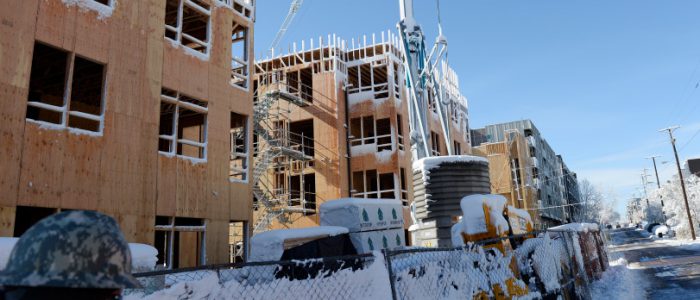
Denver area still lags in new home construction
This article was published through the Denver Post by Aldo Svaldi on February 12, 2017 at 2:30 am and updated on
Denver area still lags in new home construction
The metro area market needs 16,000 to 18,000 new homes a year to keep pace with population growth
Metro Denver’s housing woes boil down to one easy to state but incredibly difficult to resolve problem —a lack of enough new home construction.
“We add jobs, but we don’t build homes. The problem is that we don’t build enough homes,” housing economist Elliot Eisenberg told a gathering of the Colorado Association of Realtors on Tuesday.
Eight years into an economic recovery, the country still is starting only around 800,000 single-family homes a year, a level associated with residential construction activity during recessions, he said.
“Colorado is growing at twice the pace of the country, but you have housing starts that are at 1995 levels. That is your problem,” said Eisenberg, previously a senior economist with the National Association of Home Builders who started his own economics firm called GraphsandLaughs.
Every 90 days, Metrostudy, a Hanley Wood company, goes out and counts the number of foundations poured in the markets it tracks. Last year, it counted 11,038 home starts across metro Denver.
That was up 22 percent from 2015 and a huge improvement from 2009, when only 2,718 homes started. But it remains far below the construction peak reached in 2005, when just over 20,000 homes were built.
It also falls well short of what the region needs, even after accounting for heavy apartment construction, said John Covert, Metrostudy’s Denver market director.
“We are not back to historical averages, nor are we at recessionary levels,” Covert said.
Covert estimates the metro Denver market needs 16,000 to 18,000 new homes a year to keep pace with a larger population and all the people moving here. More of the mix will also need to shift from higher-end properties to lower-priced units, where margins are thinner but demand is higher.
Getting there, however, will take time. Although Denver-area home builders increased production 22 percent last year, Covert said they are more comfortable growing 10 percent to 15 percent a year.
At 15 percent growth a year, the metro Denver market gets to the volume of new homes it needs around 2019 or 2020. Two major obstacles, however, remain: finding enough lots and enough construction workers in a state that already struggles with one of the lowest unemployment rates in the country.
The oil and gas downturn freed up workers, who moved into construction in 2014 and 2015. But early indications are that trend will reverse this year as drilling activity picks up.
Another factor that creates low inventory: Older Americans, in large part, are choosing to age in place, locking up larger homes that young families desire but can’t find, Eisenberg said.
Covert said builders in metro Denver are finding success with “move-down” homes for baby boomers. But the key is building homes that will sell for less than the older homes empty-nesters are leaving behind.
Across the country, investors took advantage of depressed prices during the downturn to purchase millions of homes and convert them into rentals. Unlike in past cycles, private equity firms and real estate investment trusts, seeing a rare opportunity, pushed into the market.
Although those deep-pocketed buyers may sell at some point, they have figured out how to efficiently manage their properties, effectively creating a new institutional asset class, Eisenberg said.
Rising interest rates are likely to lock even more homeowners in place. Borrowers sitting on a low 3.5-percent rate on a 30-year mortgage need a stronger motivation to buy a home using more expensive money than vice versa.
But it is the lack of new supply that puts the greatest pressure on the existing home market. The northern Front Range started feeling the squeeze of a constrained market in 2013 and 2014. Inventory shortages last year gripped Colorado Springs and they’ve crawled over the mountains into nearby resort areas.
“2017 is shaping up to be no different than 2016,” said Anthony Real, an agent with Remax Alliance in Arvada. “Right after Christmas, the market popped. Spring came early.”
The inventory of single-family homes available for sale in metro Denver at the end of January was 2,993, a 10.9 percent drop from January 2016, according to the Denver Metro Association of Realtors.
Fewer homes for sale translated into fewer homes being sold and put upward pressure on prices. The median price of a home sold in metro Denver, either single-family or condo, rose 9.5 percent in January, far beyond the gains in income needed to cover those higher costs.
Covert said everyone is watching to see when metro Denver will hit its “price ceiling,” but so far buyers seems willing to pay up on new and existing properties.
Strong home price appreciation year after year in markets like Denver has raised fears of another bubble. But Eisenberg notes that despite the run-up in home values, total mortgage debt has remained flat for years and home construction remains anemic.
“We are not in a housing bubble. There are tons of problems in housing. None of them have to do with too much credit,” Eisenberg said.
To be redirected to article in the Denver Post, please click http://www.denverpost.com/2017/02/12/denver-new-home-construction/.


